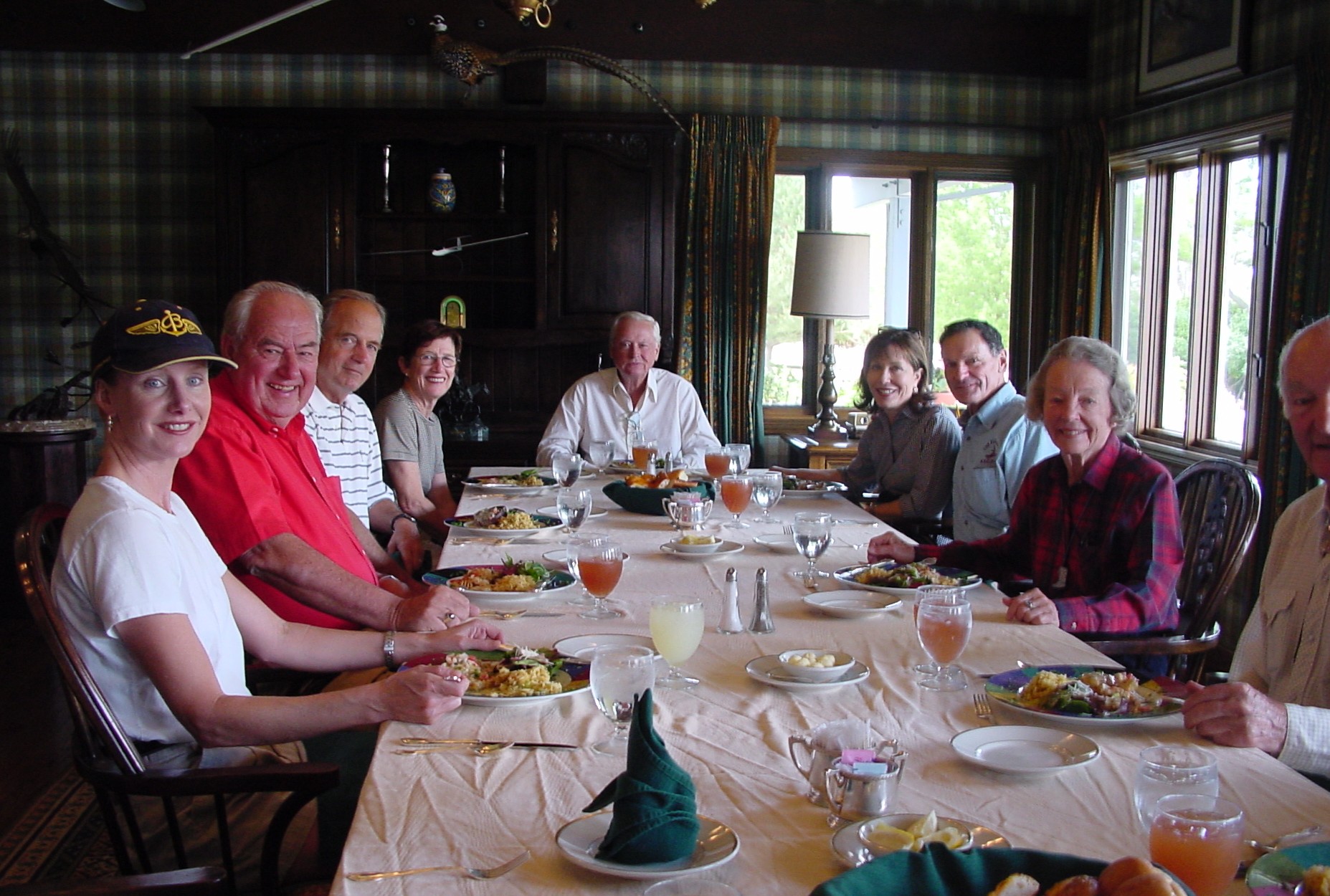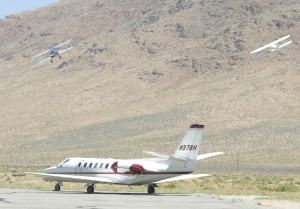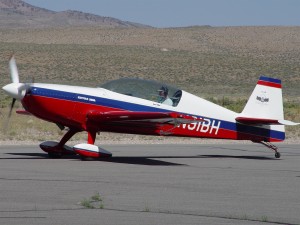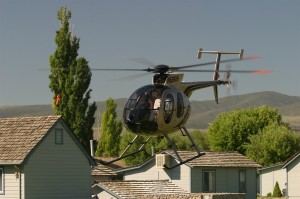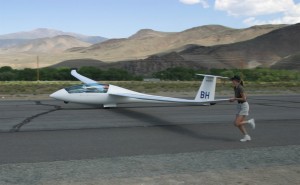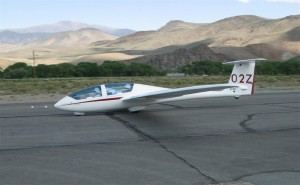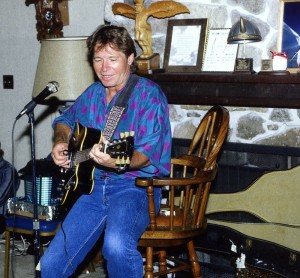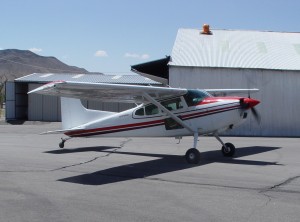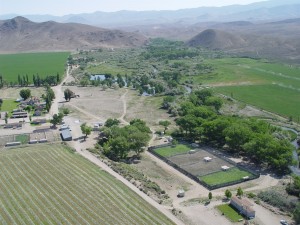By Di Freeze
It’s 6 a.m., and Barron Hilton and a few of his friends visiting the Flying M Ranch and Conference Center in northern Nevada are ready to launch in a hot air balloon.
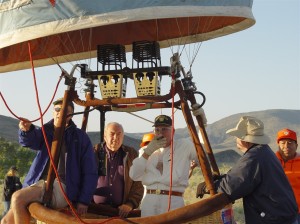
L to R: Dennis Ivans, Clay Lacy, Barron Hilton (the “Wizard”) and two of the Flying M Ranch’s ground crew.
As the balloon is being readied, Mike Gillis, a pilot for Hilton, says in a helium-induced Munchkin-type voice, “Are you really a wizard?
Everyone laughs, and Gillis looks around, asking who has the ruby slippers. However, at this gathering, no one wants to click his or her heels to go home. Rather, the popular consensus seems to be, “There’s no place like this ranch.”
As to who visits the Flying M, frequent guests include astronauts such as the late Alan Shepard, Gene Cernan and Bill Anders, Academy Award-winning actor Cliff Robertson, Bob Hoover and Carroll Shelby. These arrive simply because they are friends of the “innkeeper.” Others earn their entry into this paradise by being winners of Barron Hilton Cup competitions.
On one weekend in June, guests included John W. Myers, 92, at one time chief test pilot at Northrop as well as Lockheed, who flew into the ranch left seat in a Lear 24 owned and flown by Clay Lacy, owner of Clay Lacy Aviation, who has 50,000 hours of flying hours and counting.
Peter Ueberroth, organizer of the 1984 Summer Olympics in Los Angeles and former baseball commissioner, was making his first trip to the ranch with wife Ginny, and Richard Bertea, former commissioner for the gymnastics venue at the Los Angeles Olympiad, as well as his wife Hyla.
Other guests included Dennis Ivans, who has been coming to the ranch for 20 years, and lately arrives as a newlywed, with wife Molly, as well as Patrick Barry, managing director, and Hannes M. Linke, competition director, of the Barron Hilton Cup, as well as William F. Ballhaus, who has designed aircraft for Northrop.
Aviator Barron Hilton
Barron Hilton developed his passion for aviation long before he took the position of CEO, president or chairman—his present title—of Hilton Hotels Corporations.
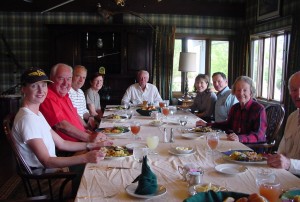
From head of table, clockwise: Barron Hilton, Hyla and Richard Bertea, Holly Ciedeberg, Bill Ballhaus, Molly Ivans, Clay Lacy, and Peter and Ginny Ueberroth.
Hilton has more than 7,300 hours in gliders, balloons, helicopters and single- and multi-engine aircraft. It all began when he was about 10, when, while living in Dallas, he began riding his bicycle to nearby Love Field.
“I used to see the airplanes in the air, and I wanted to go out where they landed,” he said. “I’d go and just stare at those planes and eat my heart out, trying to figure out when I’d be able to fly one.”
Hilton’s dream was realized during his service to the Navy in World War II. He went to boot camp in San Diego, and was there when the war ended. During his 15 months of service, he served as a photographer’s mate.
“When I went through boot camp they asked me if I had any hobbies, and I said photography, so they put me into a photographic-type situation,” he said.
While stationed in Hawaii, Hilton took flying lessons on his own time, at a civilian air base at North Shore, Oahu, learning to fly in a Piper Cub. He received his pilot’s license in 1946.
After the war was over, he attended the University of Southern California’s Aeronautical School, where he earned his twin engine rating. He commuted weekly from his home in Los Angeles to the USC campus in Santa Maria, Calif., in his Cessna 140, which at the time was only the third private airplane to be based at Santa Monica Airport. (Before then, the airport was where Douglas manufactured a lot of their military aircraft; the plant was closed after the war years.)
Hilton’s father, the late Conrad Hilton, founder of Hilton Hotels Corporation, would at one time remark that he supposed it was progress that “he rode a horse and his son casually used an airplane.”
However, Barron Hilton would be at the school for less than a year, choosing to marry Marilyn Hawley and begin a family instead.
Hilton’s involvement in aviation continued when he founded the Air Finance Lease Corporation, in 1955, through which he leased and sold commercial aircraft, including two Lockheed Electras to PSA, two Lockheed 1049H Constellations to Flying Tigers, and another Constellation to TransOceanic Airlines.
In fact, even through Hilton Hotels Corporation, Hilton left another mark on aviation. In 1959, he saw the fruition of his labors to pioneer the concept of airport hotels, through the first one, the San Francisco Airport Hilton. The company now boasts 40 airport properties located strategically in major markets in the U.S.
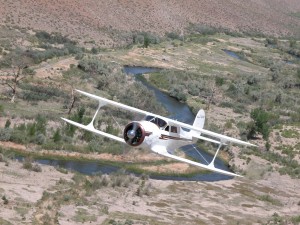
Barron Hilton’s prized Staggerwing, with Mike Gillis at the controls, approaches the Flying My Ranch, en route from Reno/Tahoe International.
Over the years, Hilton owned several aircraft, including a Beech Staggerwing he acquired around 1947, a Cessna 195, a DC-3, a Lockheed Lodestar, Aero Commanders and a de Havilland Dove.
In the mid-1960s, he acquired the Flying M Ranch, which was previously owned by Stanfield Murphy of San Francisco, and had a dirt strip.
“He used to fly in here,” said Hilton. “My wife’s name is Marilyn, so I figured I might as well keep the name Flying M.”
Hilton’s partners in the venture included Donald Douglas Jr., Stuart Abercrombie, Robert Peterson and Bill Shay of the Wrather Corporation. He bought his partners out in 1972.
It was after he acquired the ranch that he began what John Myers calls “Mr. Hilton’s Toy Store.”
Hilton arrives at the ranch in his Cessna Citation V Ultra, but Lacy, who arrived in the same Lear he flew Hilton in when they met in 1965, said that here, nobody pays any attention to the jets.
“Jets are just how you get here,” he says.
Hilton no longer has his original Staggerwing, for which he paid $5,000. He explains that a friend borrowed it, flew it to Mazatlan, and ground-looped it. However, he acquired another one about three decades ago. The Staggerwing, he said, is “the most beautiful girl I ever met.”
“The Staggerwing was way ahead of its time,” he said. “It was regarded as one of the most exciting type of aircraft because of its looks. A lot of corporations used the plane as an executive aircraft at that time. From a looks stand point, the Staggerwing will draw a crowd when you go into an airport today.”
Hilton’s Stearman, which he took delivery of in the late 1980s, is actually a Bull Stearman, because it has a 450-hp engine instead of 225.
“It gives it a lot better performance, particularly at this altitude,” Hilton said.
That Stearman, as well as other aircraft, such as his Citabria Decathlon, provided several guests on this weekend “IMAX” trips over the vast property, often courtesy of Gillis and Ivans.
A Cessna 185, which he has had for about 20 years, is used as a tow plane. Hilton presently owns an MC 500-E, and says he bought his first helicopter over three decades ago; he took some training but didn’t get his license until he was about 65.
“My friends flew them for me before that,” he said. “Bill Black, a friend of mine, had been a helicopter pilot in the service. When the first President Bush got elected, he went back into the State Department. That’s when I decided I had to get myself rated. It provided me a lot of enjoyment.”
Then, Hilton owns an Extra 300.
“I just go up and have a lot of fun, do a few rolls,” he said.
Hilton says he can do 4-point rolls, but doesn’t consider himself an extraordinary aerobatic pilot, just one “attempting to do the maneuvers in a correct manner.”
Hilton has five gliders at the ranch: a Grob Twin III Acro, a Duo Discus (two-place) that was recently acquired; a Discus B (single-place); a Schweizer 2-32 and an ASW-20.
Not all gliders are created equal, and Hilton, sitting in the cockpit of his Grob, comments on the difference between those that he’s flown and his new Duo Discus.

Barron Hilton’s Bull Stearman is the perfect vehicle to offer an IMAX-type journey over the vast Flying M. Ranch.
“This is a lot more comfortable,” he says. “On the new one, they made the cabin area here a lot thinner. They don’t give you the room, but they gave you better performance; it’s a competing aircraft. Hell! I’m not flying for performance. I’m flying for comfort. But if you want to enter a meet, go cross country for record flying or competing, the other aircraft will outperform this.”
Although Hilton doesn’t compete, he has done a 300K on a triangular course.
One glider, a Libelle 301, is on display at the Pylon Bar, next to Johnny Rockets at the Reno Hilton, which he says resembles a museum.
“It gives the people that go there the atmosphere of the Reno Air Races,” he said. “I’ve got a replica of one of my balloons there as well.”
The décor at the Pylon Bar includes pictures of Hoover’s P-51, Hilton’s Staggerwing, a Gee Bee and a balloon mural. When Hilton decided to retire the glider, he though the Pylon Bar was the perfect place for it.
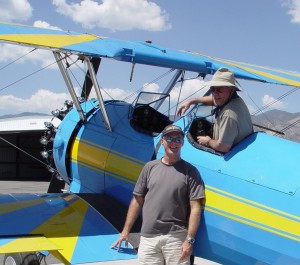
Mike Gillis, in the cockpit of the Bull Stearman, and Dennis Ivans, take a break between flying guests.
“It was one of the first gliders I had; it was over 30 years old,” he said. “That’s the one in which I checked out Alan Shepherd, Gene Cernan and John Denver. Cliff Robertson flew it, too.”
Hilton and Robertson became acquainted when the actor was in the area, at a soaring meet.
“There’s a whole bunch of us who have a love for flying, and we just get together,” he said.
Denver, who flew several different aircraft, including a Waco, traveled to the Flying M Ranch several times before his death, including one visit with his son and daughter.
“I don’t think I’ve seen many aviators who could accomplish what John did in one week,” said Hilton. “He had never flown gliders before he first came here. He not only got checked out in a glider, but he even got checked out towing gliders in the 185. He goes for the 300K gold badge, stays aloft for five hours, and makes it.”
“John had his own Lear up in Colorado,” Hilton said. “His father was a colonel in the Air Force, and his whole background was flying. I flew with him on several occasions. He was an outstanding pilot.”
After a day of flying, Denver would graciously serenade Hilton and his guests with his ever-present guitar.
It doesn’t seem that Hilton ever lets any of his aircraft sit idle for long.
“Today he flew the balloon, the helicopter, the Extra 300 and the Grob,” said Lacy. “Yesterday he flew the Staggerwing.”
Lacy chuckles and says that Hilton can definitely afford the aircraft, but the great part is that he lets his friends fly them.
“No one is more generous than Barron,” he says.
Linke adds that when everybody’s out there flying his toys, Hilton has the best time.
“He’ll stand here with his handheld radio, and he’s in Heaven,” Linke said.
Lacy confirms that Hilton is “Center Control.”
“He’s so happy that all of his friends are flying airplanes and having fun,” he says. “He just likes to see them all in the air.”
Barry adds that Hilton, however, is careful as to whom they put in which airplane.
The Flying M Ranch
As described in a video by Denver, the Flying M Ranch, 60 miles south of Reno, is “an awesome panorama of mountains and deserts.” Cliff Robertson, in a poem that graces the wall in the main dining area, calls it “a place of magic.”
The ranch covers an area that begins 25 miles south of Yerington, Nev., and stretches to the shores of Mono Lake in California. The Wassuk Mountains in the east and the Masonic Mountains in the west form the other boundaries of the ranch.
Trout fishing is available at the ranch via the East Walker River, while trout and bass fishing are also available through manmade lakes. Deer and elk can be spotted roaming freely, and swans gracefully swim in a beautiful pond.
Nearby is Mount Grant, as well as the Toiyabe National Forest, six miles north of the ranch. The Sierra Nevada range looms to the west of the property.
Across from the main house is an old stagecoach house. Erected in the mid-1800s to house mules that hauled produce and firewood to the boomtowns of Aurora and Bodie, it is the second-oldest building still in operation in Nevada.
In fact, Bodie, on the border between California and Nevada, is on Hilton’s property, which, according to visitors, is about as big as Rhode Island. Hilton explains that the property includes 20,000 acres owned by him, at fee, and 980,000 acres of Bureau of Land Management property, making for a million-acre ranch.
“I lease the land from the government,” he says.
In the main ranch house, where Hilton has his private residence in one wing, walls are decorated with photos of various aircraft, Hilton family and acquaintances. The main house also holds two dining room facilities. A smaller one is for made-to-order breakfasts. At a larger formal area, guests gather with their host like clockwork for five-star lunches and dinners. On this weekend, that included salmon, filet mignon, abalone, and elk medallions with huckleberry sauce, all created in a gourmet professional kitchen by a chef from the Reno Hilton, and served by attentive wait staff.
At six in the evening, an hour before dinner, guests begin arriving at the bar for cocktails, leisurely enjoyed there or in a big screen display room, where videos can be displayed or guests can catch up on news, or sip their refreshments in an adjacent reading area.
Besides the main ranch house, the complex includes several cabins for visitors, such as the French Suite, The New Mexico House and Balloon Cottage, as well as pilots’ quarters.
The Barron Hilton Cup
Hilton’s interest in gliding goes back to an encounter with Hannah Reitsch at a meeting of the Society of Experimental Test Pilots at the Beverly Hilton, in 1972.
Reitsch, being honored for her unique career as high-risk test pilot, was also one of the first to cross the Alps in a glider. She set more than 40 altitude and endurance records in motorless and powered aircraft. In 1945, she flew the last plane out of Berlin, hours before the fall of the city. She was the only woman ever to be awarded the Iron Cross and Luftwaffe Diamond Clasp.
“She told me the greatest thrill of her life was soaring over the Alps,” said Hilton. “I said, ‘Well, I’ve got a ranch up in the Sierras. Do you think it would be any good? She said, ‘I know it would be.’ That Monday, I had my chief pilot get me a soaring aircraft—a Schweitzer 2-32.”
Hilton soon found that the soaring wasn’t merely good at the ranch, but that it was one of the best soaring places in the world, due to thermal updrafts generated east of the Sierra Nevada range.
“Soaring has added a whole new dimension of pleasure to my life,” said Hilton.
He says his opportunities to soar are relaxing times, and that he’s had great experiences.
“One of the greatest thrills that I remember was flying to the top of Mount Grant, which is 11,300 feet, about 20 miles from here,” he said. “On this particular day, a westerly wind enabled me to ridge soar. The snow-capped peaks of the Sierras stretched for some 50 miles on the horizon to the west. It was a beautiful blue sky and there were about 10 eagles all ridge soaring up there on top of that mountain.
“They’re territorial. They don’t generally go into one another’s territory, but if they decide to play some place, they have a spot they all gather in, and this was that time when they all flew from their own territory, on top of that mountain. Here I am with all those eagles up there soaring back and forth on top of Mount Grant. What a thrill that was.”
His discovery has also added pleasure to many other lives, through the Barron Hilton Cup, in which the European Aeronautic Defence and Space Co. is his partner, and Lufthansa is the official airline. The world’s largest sailplane competition, it’s recognized by the Federation Aviation Internationale as the only Category One competition on the international soaring calendar, other than the biennial World Championships. More than 3,000 flights are entered during each two-year competition period.
The Barron Hilton Cup was conceived in 1981, when Dr. Helmut Reichmann, the late three-time world soaring champion, Frank Franke and the late Dr. Hardy Baer visited Hilton.
“Helmut told me they wanted to do an international event,” said Hilton. “I said that sounded like something I’d be interested in doing.”
Reichmann told Hilton that pilots dream about being in the conditions available at the ranch. Linke, an inductee in the U.S. Soaring Hall of Fame, began soaring when he was 14. He got involved with the Barron Hilton Cup through his long acquaintance with Reichmann. They set up a meeting with Hilton, Franke and Linke, who was a trusted friend who knew his way around local soaring circles.
Barron Hilton Cup flights are triangular flights of at least 400K (248.56 statute miles). The points are calculated using a handicap so that sailplanes of all types have an equal chance of winning.
Glider pilots who complete the longest triangle flights in each of eight divisions from around the world win a 10-day soaring camp at the Flying M Ranch, where a number of international soaring records have been set. The first gliding camp was held in 1981.
Although the prize is being able to come to the ranch and enjoy it, Hilton adds that there is a trophy, but the organization retains it.
“We do make presentations to the pilots,” he said. “Usually I’ll have Gene Cernan, Bill Anders and Cliff Robertson participate with me while we present the Barron Hilton Cup Soaring Medal.”
“Another glider pilot of note is Ulf Merbold, a German astronaut of the European Space Agency, who has flown on both the shuttle and on MIR,” Barry added. “His talent as a pilot, and his perspective on the space program, make him a most welcome guest.”
Ballooning
Hilton presently has three hot air balloons. Barry, who was with Hilton Hotels Corporation before branching out on his own in public relations, explains how Hilton ended up with his first, in the mid-1980s.
“We had a general managers’ meeting at the Beverly Hilton,” he said. “We had a gift to give Barron on behalf of all the managers. All our meetings were in the main building, but there’s a garden courtyard with a pool area surrounded by guestrooms. We bought a balloon because we knew of his love of flying, and had it standing up there. He had no idea why he was being led through this entryway. It was the best gift we could have ever gotten him. When he saw it, he was just delighted. That weekend, we flew an instructor up to the ranch, and he was checked out in a week.”
The first time Hilton flew the balloon at the ranch was an unusual event.
“The coyotes from 360 degrees around us were all yelping,” Hilton said. “The next morning, I never heard a peep out of them. They must have gotten together and decided that I wasn’t a threat.”
Hilton was the principal sponsor of the Earthwinds Hilton, the first attempt to circumnavigate the earth in a manned balloon. Adopted from a NASA design by Captain Larry Newman, the double-balloon system was designed to control the craft’s altitude as it flew in the jet stream around the world.
The helium in the upper balloon expanded during daylight hours, then contracted at night, causing it to lose altitude and fall out of the jet stream after dark. By pumping compressed air into an anchor balloon suspended below the gondola, the crew could increase or decrease the amount of ballast it carried during the flight, thus preventing the craft from descending after nightfall.
Two launch attempts were shorted due to excessive winds at launch, and two more resulted in successful launches, but the flights were cut short by mechanical failures. Finally, on Dec. 31, 1994, the craft successfully climbed to 29,000 feet, but the fabric on the lower balloon failed under the pressure of the compressed air at high altitude.

L to R: Hannes Linke, competition director, Barron Hilton Cup, John Myers and Pat Barry, managing director, Barron Hilton Cup, enjoy their host’s hospitality.
While the double-balloon system proved unworthy of the task, media attention generated by the flights inspired five teams from around the world to make world flight attempts over the next eight years. While falling short of the ultimate goal, several long flights were later made, demonstrating the reliability of the Roziere balloon system. The Roziere’s helium envelope is warmed by a hot air system around it, enabling the crew to heat the helium at night to duplicate the warming effect of the sun. This technology prevents the craft from losing altitude during the night.
Encouraged by the development of that lift system, Hilton backed another effort to circumnavigate the earth early in 1998, known as the Global Hilton. Pepsi Cola Company and Hilton Hotels Corporation joined Hilton in sponsoring the project, headed by Dick Rutan, the pilot of the Voyager’s historical transglobal flight of 1986, and Earthwinds’ veteran Dave Melton. After a flawless launch from Albuquerque, N.M., on June 9 of that year, the helium envelope suddenly failed two hours into the flight.
“We had a very good takeoff but when the balloon got to altitude, the helium envelope erupted,” Hilton explained. “All they had was the hot air balloon at that point. They were descending and the crew made the determination to bail out. They thought they tied off the helium valve before parachuting to safety—and probably did—but when the craft hit the ground, with nobody aboard, several tanks dropped off and it dumped a couple thousand pounds of propane.”
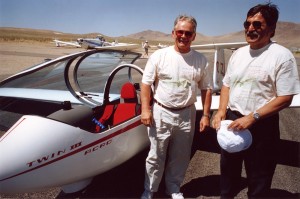
L to R: Hannes Linke, competition director, Barron Hilton Cup, with Manfred Bischoff, chairman of EADS, on a past visit to the ranch.
The craft was now much lighter, and it bounced back up to 35,000 feet, and started to float across the U.S.
“We didn’t know where it was going to come down,” Hilton said. “Because it had a lot of propane in it, it was like a bomb. Of course, my concern was that it had my name on it. It ended up touching down in Gainesville, Texas, about 30 miles from Dallas, on a farm owned by Danny Darwin, a pitcher for the San Francisco Giants.
“He was there at the time and it came in and hit some high power lines and caught on fire. The only causality was a cow that had freaked out; it jumped into a lake and drowned. Danny was very helpful. All Danny wanted was a photograph of the crew. They autographed it for him in Albuquerque.”
Hilton called the late Don Engen, who previously had headed up the FAA, and said, “Don, I have a problem. I have this balloon floating across the country and I think NORAD is the best to handle it.”
“He said he’d call them,” said Hilton. “NORAD already knew where the balloon was; they had been following it and we had transponders aboard, so the centers would know where the balloon was. It was very high tension, and when the crew bailed out, Dave Melton broke his hip during a high-wind landing.”
Although the ultimate goal of flying around the world hadn’t been achieved, Hilton said they had fun trying. It was Bertrand Piccard and Brian Jones who eventually became the first to fly non-stop around the world in a balloon on March 21, 1999. Later, after making five global attempts, Steve Fossett became the first pilot to circle the globe solo in a balloon, on July 4, 2002, crossing the finish line in Australia.
All three cite Hilton as the inspiration for their pursuit of this great aviation milestone. Hilton is reluctant to talk about his participation in Fossett’s success, but others acknowledge he played a large role. Besides helping him raise funds, Hilton made a substantial contribution to the project and helped create the mission control center at Washington University in St. Louis. He talked with Fossett twice during his milestone flight and the command center called daily to give him reports.
Honors, Contributions and Associations
Hilton has been a proud member of Conquistadores del Cielo, an organization of aviation executives, for more than 25 years. Members include Charlie Gates, who hosts an annual meeting at his ranch.
“We’ll be getting together in September,” said Hilton.
This year, Hilton plans on attending with Myers.
“John is the oldest member of the Conquistadores,” said Hilton.
The fact that Myers is still flying, says Hilton, should bring a smile to the face of many pilots who may be nearing the age of 75, and might think he or she should retire because they’re “too old to fly.”
“This guy is 92 and he still flies his own jet!” Hilton says.
Hilton also attends the Reno Air Races every year and the EAA Fly-In at Oshkosh most years.
“We have a Hilton Garden Inn that was built right on the Oshkosh airport and my pilots taxi right up to the back door of the hotel,” he said.
Lacy says that besides loving aviation, Hilton really helps promote it, while Barry refers to Hilton as “the Patron Saint of Sport Aviation.” His deep involvement has led to significant contributions to various organizations, including a $1 million endowment to the Experimental Aircraft Association’s Aviation Foundation to support the position of executive director of EAA’s Residence Education Program. The director’s primary responsibility centers on summer aviation youth camp at the EAA Air Academy.

Barron Hilton (far left) and Cliff Robertson (second from left) with winners of the Barron Hilton Cup during a gliding camp at the ranch. Hilton’s Staggerwing is flying overhead.
Lacy mentions that Hilton is also a big supporter of the Young Eagles program.
“He’s very interested in keeping young kids interested,” he said.
In fact, his name appears on the Hilton Theater, which welcomes thousands each year to see one of the world’s finest aircraft collections, at EAA’s AirVenture Museum. He also has made a video presentation, which introduces the public to the collection, and updates it periodically, when exhibits change or an event needs to be added.
In 1995, the National Business Aircraft Association presented Hilton with the American Spirit Award, created in 1994 to recognize individuals in aviation who exemplify the courage, pursuit of excellence and service to others that characterize the spirit of the men and women who created and nurtured the American aviation community.
In 1992, he was inducted into the U.S. Soaring Hall of Fame, sanctioned by the Soaring Society of America.
Praise From Companions
In a video prepared for EAA, Cliff Robertson speaks about “the world’s most famous innkeeper.”
“We friends of earth’s innkeeper are legion,” he says. “We’re everywhere. We’re in regular and constant debt, for he shares with us his passion for friends, flying, fishing, hunting, but most of all, his passion for life.”
On a particular evening, after Hilton has retired to his private chambers in preparation for an early morning flight, his friends gather around a table to talk about those passions, and extol the virtues of their host and the ranch.
Lacy, who says he’s never met a person who had anything but high regards for Hilton, adds that no one is more interested in so many different things.
“John and I often go fishing with him in Alaska. Barron told me, ‘You know, I wouldn’t mind being a guide up here a couple of months in the summer, just taking people out fishing,'” Lacy says with a chuckle. “When Barron gets interested in whatever it is, such as when he is here, sailplanes and everything, or when he goes fishing or to his duck club, he’s totally involved with it. He has so many facets.”
In 1965, Lacy flew Hilton to Las Vegas in his Lear 25, because the hotelier wanted to inspect Caesars Palace, which was just being built. That same year, he flew Conrad, Barron and Nick Hilton to San Diego. He chuckles and says that at one point, he realized that if something happened on that trip, the whole Hilton dynasty would be gone.
Lacy said that Hilton loves being an innkeeper, and that he’s a brilliant businessman, but he believes his real love is and his heart is in aviation.
“I wouldn’t be surprised that if he had it all to do over, he’d be just in aviation,” he said.
Lacy says Hilton brings a professional approach to aviation as a “nonprofessional pilot.”
“He lends credibility to general aviation, to private flying, more than anyone I know,” he says. “He approaches it from a technical standpoint and as a seat-of-the-pants skilled aviator.
Barry adds that Hilton is an incredibly conscientious pilot.
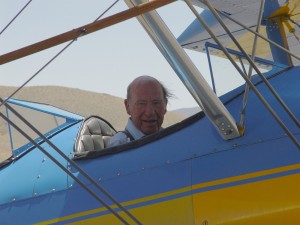
John Myers, Barron Hilton’s fellow member of Conquistadores del Cielo, in the cockpit of the Stearman. At 92, Myers still flies his own jet.
“I guess you’d say he’s a natural pilot, but I think it’s applied,” he said. “He’s proud of his flying abilities but he’s not a showoff. He’s extremely conservative. His reputation as a good pilot means a lot to him. Mike says that at Easter (when “flying season” at the ranch began) the first thing Barron did was sit in the back seat of the Staggerwing, pull out the manual and get current again on the checklist.”
Lacy says that Hilton is uncomfortable when people thank him, but Ivans says there is a way to do so without words.
“You show him you have the same unbridled enthusiasm, the same passion for the things he loves,” he says.
His love for aviation, says Lacy, extends to all aviators.
“Everyone who flies is his friend,” he said. “For example, when we were out here earlier on the back porch, there was a Pawnee pulling a glider off the strip. Some guy landed here, trying to get somewhere, and they brought an airplane here and picked him up. Barron says, ‘I didn’t hear him land. We should have invited him up here and talked to him! Why didn’t he let us know he was here?’ He was really unhappy.”
Linke recalled a time when a Frenchman landed in Yerington, and Hilton sent his tow plane to get him and bring him to the ranch, after talking to him on the radio.
Several decades ago, Hilton voiced that one day a Lunar Hilton would accommodate tourists’ brief stopovers on a continuing journey to Mars or other planets. That hasn’t happened—yet—but Hilton does often bring “the moon” to his ranch.
“If Barron Hilton calls or writes an astronaut, they come,” says Lacy. “He has one of the most recognizable names probably in the world. The wonderful thing is that he can invite all kinds of people that are interested in something he’s interested in. Those of us that are just lucky enough to be hangers-on meet interesting people.”
Many guests have stood enthralled while Shepard, Cernan or Anders pointed to the places on the moon they had explored during their Apollo missions or when Hoover, Myers or others told their test-flight stories. One is Ivans.
Ivans began coming to the ranch with his father, the late Bill Ivans, who, in 1999, at the age of 79, died when his motorized glider experienced an in-flight breakup. He was soaring with longtime friend Donald Engen, 75, director of the Smithsonian National Air & Space Museum and former administrator of the FAA, who was also killed in the incident.
Ivans, who joked that he was born to crew gliders, worked at the Smithsonian for three years and says he took for granted how he was exposed to the people he met first hand. He doesn’t take that for granted anymore.
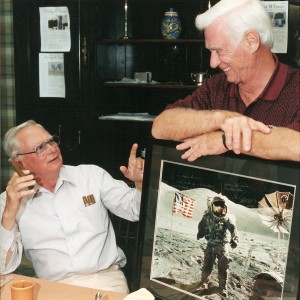
L to R: Barron Hilton shares a light moment with Gene Cernan, the last man to walk on the moon, on one of Cernan’s past trips to the ranch.
“I’ve never been anywhere else in my life where you can have such a diverse group of people and everyone’s equal and gets to share,” he says of the times at the Flying M Ranch. “It’s the human part behind the stories that’s cool. You’re just mesmerized; it’s so unique. But it’s the whole environment of this ranch. You can’t replicate it.”
However, says Ivan, you can’t remove Hilton from the equation.
“There are all these beautiful things here, but if you come here without Barron, it’s not the same,” he said. “He makes this place. He is the consummate host.”











